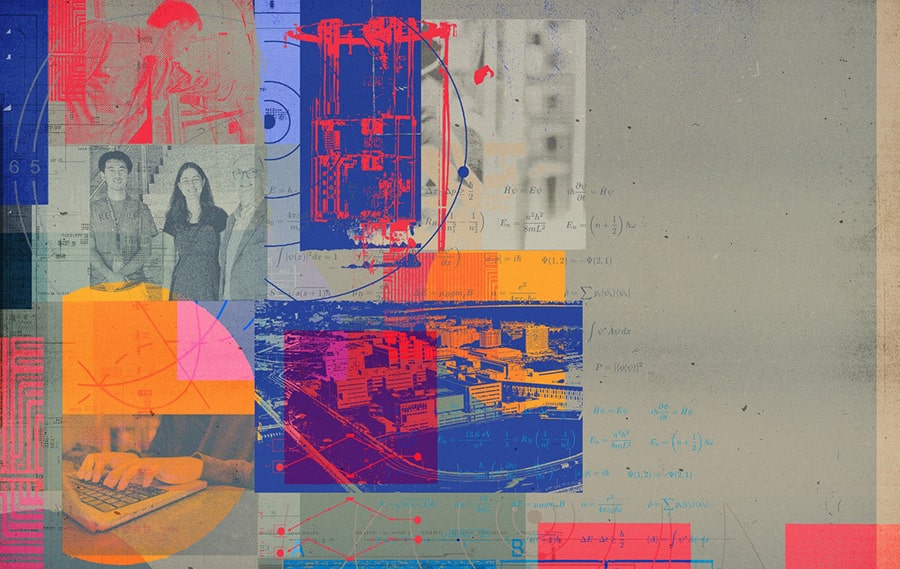- Home
- News
- Recent News
- Impact is Inevitable
Impact is Inevitable
Quantum mechanics challenges what we think we know about how the world works— and shows physicists and engineers a doorway to astonishing technological possibilities. UMass Boston is exploring how public research, interdisciplinary education, and industry collaboration might unlock the power of the quantum world.

In June 2025, UMass Boston physics professor Christopher Fuchs arrived on the remote island of Helgoland, Germany, to mark the 100th anniversary of the field of quantum mechanics. He and more than 300 physicists, including Nobel Prize laureates and other luminaries, had gathered to celebrate the landmark—a scientific breakthrough so momentous that UNESCO has named 2025 the International Year of Quantum Science and Technology.
In its centennial year, quantum mechanics is both the force behind everyday technologies and the catalyst for the next generation of discovery. On the cusp of the next 100 years of quantum mechanics, UMass Boston has positioned itself, through academic research, student training programs, and quantum-enabled core facilities, to be a leader in its next phase.
“Boston has long been a central hub for research and computing technologies,” said Akira Sone, assistant professor in the Department of Physics. “UMass Boston, together with institutions like MIT and Harvard, is sharing resources and building up education and research within the city. It’s the perfect place for it.”
Quantum Mechanics is Everything
The Helgoland 2025 conference took place on that hard-to-reach island because it is the site of, according to legend, a quantum-physics eureka moment on par with Newton’s apple. German scientist Werner Heisenberg came to the island in 1925 to escape terrible hay fever. His memoirs relate that during one sleepless night, he was struck by his theory of matrix mechanics, a foundation of quantum physics.
In truth, that breakthrough might have been more a result of collaborative effort than an epiphany— Heisenberg had been working on his calculations for months, building on the ideas and input of other early quantum theorists like Niels Bohr and Wolfgang Pauli.
But it is indisputable that, by unlocking the way matter works on the subatomic level, Heisenberg and his fellow quantum pioneers changed how we understand the world.
Quantum physics is about mechanics—the ways forces act on and move physical bodies—but also uncertainty. It looks at the subatomic particles that make up all matter. Smaller than one-billionth of a centimeter, they don’t move or act in ways that physics at larger scales would predict. The more you know about where a subatomic particle is going, for example, the less you can know about where it is. But with quantum physics, you can calculate the probability of finding it in different spots.
If you’re confused, you’re not alone. Quantum mechanics is a slippery concept to grasp. “It’s strange, it’s interesting, it’s counterintuitive,” said Sone.
Maxim Olchanyi, professor in the Department of Physics, uses sleight of hand to explain it. “Card tricks show things that both are and aren’t,” he said, like quantum states that don’t exist until they are measured. “The laws of quantum are impossible to visualize without magic.”
But for those living and breathing this science, understanding subatomic probabilities and harnessing their power has already led to revolutionary technologies. Quantum mechanics drives the design of modern electronics like cell phones, as well as lasers, nanoscale atomic force microscopes, and atomic clocks essential for the global positioning system (GPS).

A Computing Revolution
One particularly exciting area of quantum innovation is computing. Due to subatomic properties like superposition (in which a particle whose state is undetermined functionally exists in all possible states at once, bits of data at the quantum scale can interact in ways far more complex than classical computing’s on (1) and off (0) binary allows. As a result, “you can write things in a programming language that you can’t for regular computers,” said Fuchs.
String a lot of these quantum bits together, and you have a new kind of computing power. “You can speed up exponentially,” said Sone. “Where a classical computer might take years and years to solve a problem, a quantum computer can solve it within seconds.”
While quantum computers exist now, they aren’t yet scaled to the level that physicists theorize would unlock their true power. UMass Boston is working to help change that.
Quantum at UMass Boston
UMass Boston’s College of Science & Mathematics has already begun laying the foundation for a robust Quantum Information Science & Engineering (QISE) program, building on the knowledge and research interests of academic leaders and faculty within the departments of engineering and physics.
UMass Boston is an ideal place for this work because of the expertise already on campus. In the past two years alone, UMass Boston faculty have received major recognition and more than $5 million in grant funding for their work in both the practical and theoretical aspects of quantum science.
Their studies address an array of areas in the field. Olchanyi is investigating number theory–inspired effects on cold atoms, one of the few attempts in the world to use quantum mechanics to study number theory. Fuchs established QBism, a view of quantum mechanics in which particle probabilities are determined by an observer’s expectations rather than objective reality—work that landed him on Vox’s 2023 Future Perfect 50 list of innovators shaping our global future.
Sone is advancing AI-based approaches to quantum science and technology research and education. And Robin Côté, distinguished professor of physics, former dean of the College of Science & Mathematics, and head of the university’s new interdisciplinary Data & Quantum Science Center (DataQS), is leading a grant designed to deliver high-quality research, grow faculty, and establish a workforce development infrastructure with industry partners.
“It is truly inspiring to see our faculty and students receiving national recognition and support for their groundbreaking research,” said Provost Joseph Berger. “We’re proud to support such visionary work that not only deepens fundamental understanding but also elevates our academic community on the global stage.”
Impact Through Industry
Supporting the quantum industry is key to the university’s growth trajectory in quantum technology. UMass Boston is home to the Quantum Hardware Development & Commercialization Core Facility. There, Associate Professor Matthew Bell, director of the core facility and chair of the Department of Engineering, along with students and staff, works with both local start-ups, such as Millimeter Waves Systems and Quantum Microwave, and established international companies, such as Raytheon, to provide the facilities and know-how they need to test their quantum devices.
This kind of facility is crucial because quantum development can’t be run in a regular testing facility or lab. These devices need to be cooled to temperatures unimaginable to most human beings, down close to absolute zero (-459.67 degrees Fahrenheit or -273.15 degrees Celsius). The core allows companies to “develop prototypes and components relevant to emerging technologies in the new quantum economy,” said Bala Sundaram, professor of physics and vice provost for research and strategic initiatives.
Often, the work of the core facility is synergistic with UMass Boston’s Venture Development Center (VDC), an incubator where students, faculty, and entrepreneurs come together to launch innovative technology and life sciences into the world. For example, the start-up Atlantic Quantum collaborated with faculty to characterize a computer chip it developed. FerroByte, which is developing new materials specifically designed for use in facilitating quantum technologies, has also joined the VDC.
Intertwining quantum computing and artificial intelligence (another field UMass Boston faculty and students are heavily involved in) could lead to AI that not only learns faster but also reshapes how machines think by using the fundamental rules of quantum mechanics. This is being explored with resources at the Massachusetts Green High Performance Computing Center (MGHPCC)—a joint venture between the University of Massachusetts system and Boston University, Harvard, MIT, Northeastern, and Yale— which houses cutting-edge quantum and AI infrastructure.
Preparing the Quantum Workforce
That this work is being done at UMass Boston, the city’s only public research institution, said Sundaram, will have a “profound impact on producing the skilled workforce needed to grow and sustain these emerging sectors in the Commonwealth’s economy.”
Preparing students to join that workforce is a priority for the university. In addition to undergraduate and graduate physics and engineering degrees, UMass Boston has launched a Quantum Information Certificate program that makes the topic accessible to undergraduate students of all majors. Four courses over two years cover topics like the mathematical foundations of quantum information and the applications of quantum information across scientific systems.
The program started in 2020 and has gone through two cycles of students. While it’s still too early to track the contributions of those students to the quantum field, Côté is pleased with the program’s progress and hopes that in the future, it will expand beyond undergrads to enroll professionals who want to also ride the quantum mechanics wave.
“That could be someone from industry or an engineer who wants to retool,” he said. “You might not know anything about quantum mechanics but take this series of four courses and you have a base for quantum information science and engineering.”
As these educational efforts expand in Boston, Côté hopes that UMass Boston will become a global hub for educating quantum scientists, including students from outside the region who could come to Boston for summer school or workshops to experience the level of physics happening here that isn’t happening elsewhere.
Students from smaller colleges or universities “don’t have the occasion to really engage and see a lot of the new developments going on in the field,” said Côté. “There are a lot of great students who just don’t have access to what we have here, and there is a lot of talent everywhere.”
Into the Unknown
Guessing what quantum mechanics will enable in the next 100 years is like tracking a particle itself: you can calculate the probability of where it will end up, but not know for sure. Better devices for measurement? Probably. A full scale, working quantum computer? It’s possible. UMass Boston’s quantum experts can’t know today what the tools built by quantum mechanics will be, in the same way it would have been impossible for Heisenberg to guess that we’d use his discoveries to produce pictures of the insides of our bodies or make telephones “smart.” But they are working to illuminate the science, build the industry, and prepare students for a quantum-enabled future that is sure to bring new marvels.
“It’s like regular computers today, which are used to design new computers, and design every single product we have,” said Bell. “Once you have a quantum computer, you have a whole new avenue of possibilities to develop the next technology.”